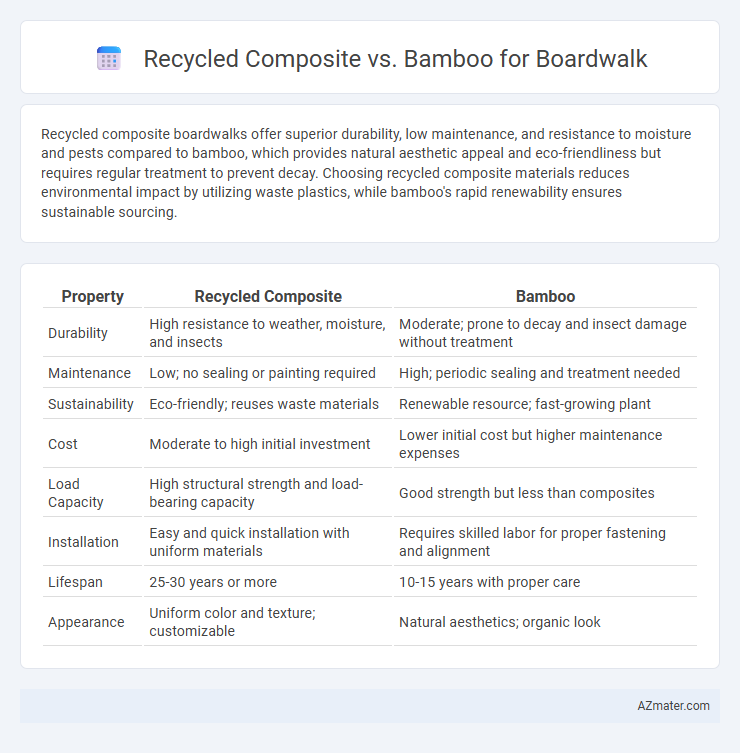Recycled composite boardwalks offer superior durability, low maintenance, and resistance to moisture and pests compared to bamboo, which provides natural aesthetic appeal and eco-friendliness but requires regular treatment to prevent decay. Choosing recycled composite materials reduces environmental impact by utilizing waste plastics, while bamboo's rapid renewability ensures sustainable sourcing.
Table of Comparison
| Property | Recycled Composite | Bamboo |
|---|---|---|
| Durability | High resistance to weather, moisture, and insects | Moderate; prone to decay and insect damage without treatment |
| Maintenance | Low; no sealing or painting required | High; periodic sealing and treatment needed |
| Sustainability | Eco-friendly; reuses waste materials | Renewable resource; fast-growing plant |
| Cost | Moderate to high initial investment | Lower initial cost but higher maintenance expenses |
| Load Capacity | High structural strength and load-bearing capacity | Good strength but less than composites |
| Installation | Easy and quick installation with uniform materials | Requires skilled labor for proper fastening and alignment |
| Lifespan | 25-30 years or more | 10-15 years with proper care |
| Appearance | Uniform color and texture; customizable | Natural aesthetics; organic look |
Introduction: Sustainable Materials for Boardwalks
Recycled composite and bamboo represent two leading sustainable materials for boardwalk construction, each offering unique environmental benefits. Recycled composite boards utilize post-consumer plastics and wood fibers, reducing landfill waste and minimizing deforestation, while bamboo, a rapidly renewable grass, sequesters carbon efficiently and grows to maturity within three to five years. Both materials provide durability and resistance to moisture and insects, making them eco-friendly alternatives to traditional hardwoods in boardwalk applications.
Material Composition: Recycled Composite vs Bamboo
Recycled composite boardwalks consist of a blend of reclaimed plastics and wood fibers, providing durability, resistance to moisture, and low maintenance requirements. Bamboo boardwalks are made from fast-growing bamboo stalks, offering natural strength, flexibility, and eco-friendliness but may require more frequent treatment to prevent weathering and degradation. The choice between recycled composite and bamboo depends on factors such as longevity, environmental impact, and maintenance preferences.
Environmental Impact: Eco-Friendliness Compared
Recycled composite decking materials reduce landfill waste by incorporating reclaimed plastics and wood fibers, significantly lowering environmental footprint compared to traditional wood. Bamboo boardwalks boast rapid renewability and carbon sequestration benefits, as bamboo absorbs more CO2 and regenerates faster than hardwoods. While recycled composites minimize deforestation and waste, bamboo's biodegradability and sustainable cultivation practices offer a compelling eco-friendly alternative for environmentally conscious outdoor construction.
Durability and Weather Resistance
Recycled composite materials exhibit superior durability and weather resistance compared to bamboo, as they resist moisture, rot, and insect damage while requiring minimal maintenance over time. Bamboo, though sustainable and strong, is more susceptible to weathering, swelling, and decay without proper treatment and frequent upkeep. For boardwalk applications exposed to varied climates, recycled composites provide a longer-lasting, resilient solution against harsh environmental conditions.
Maintenance Requirements and Longevity
Recycled composite boardwalks require low maintenance due to their resistance to rot, insects, and weathering, typically lasting over 25 years with minimal upkeep. Bamboo boardwalks offer natural aesthetics but demand frequent sealing and treatment to prevent decay, insect damage, and warping, generally lasting 10 to 15 years under proper maintenance. The durability of recycled composites surpasses bamboo, reducing long-term maintenance costs and extending service life in outdoor environments.
Installation Process and Cost Analysis
Recycled composite decking boards for boardwalks offer straightforward installation with fasteners compatible with existing wood decking tools, reducing labor costs significantly compared to bamboo, which often requires specialized cutting and treatment to prevent decay and insect damage. The initial cost of recycled composite materials is generally higher than bamboo, but lower maintenance and longer lifespan result in better long-term cost efficiency. Bamboo, while initially cheaper, has higher installation complexity and maintenance expenses due to its susceptibility to moisture and pests.
Aesthetic Appeal and Design Flexibility
Recycled composites offer a wide range of color options and textured finishes that mimic natural wood, enhancing the aesthetic appeal of boardwalks while providing consistent quality. Bamboo provides a unique, natural grain pattern and warm tones that create an organic, eco-friendly look, but it is more limited in color variations compared to composites. Design flexibility is higher with recycled composites due to their ability to be molded into various shapes and sizes, accommodating custom designs and intricate patterns.
Safety Considerations: Slip Resistance & Splinters
Recycled composite boardwalks offer superior slip resistance due to their textured surfaces and integrated anti-slip additives, reducing the risk of accidents in wet conditions. Bamboo, while naturally strong, can become slippery when wet and is prone to splintering, raising safety concerns for pedestrians. Selecting materials with proven slip-resistant properties and minimal splinter risks is crucial for ensuring a safe walking environment on boardwalks.
Regional Availability and Sourcing
Recycled composite decking materials are widely available in North America and Europe, benefiting from established recycling programs that supply consistent quantities of high-density polyethylene and wood fibers, ensuring a steady, eco-friendly source for boardwalk construction. Bamboo boardwalk materials primarily originate from Southeast Asia, with limited regional availability in other parts of the world, requiring long-distance shipping that can increase carbon footprint and costs. Sourcing recycled composites supports local circular economies and reduces dependency on international transport, while bamboo offers rapid renewability but faces challenges in sustainable harvesting certification and regional supply chain reliability.
Conclusion: Choosing the Best Material for Boardwalk Projects
Recycled composite materials offer superior durability, low maintenance, and resistance to moisture and insects, making them ideal for long-lasting boardwalks in varied climates. Bamboo boards provide a sustainable, eco-friendly option with natural aesthetics and rapid renewability but may require more frequent upkeep and treatment to withstand environmental stress. Selecting the best material depends on balancing budget constraints, environmental goals, durability requirements, and the specific conditions of the boardwalk site.

Infographic: Recycled composite vs Bamboo for Boardwalk
 azmater.com
azmater.com